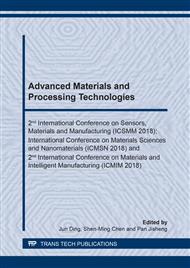p.3
p.10
p.17
p.22
p.29
p.36
p.41
p.51
p.57
Effects of the Inclusion of Armchair Graphene Nanoribbons on the Electrical Conduction Properties of NN-Heterojunction 4H-6H/SiC Diodes
Abstract:
In recent years, graphene has sparked the interest of researchers due to its promising electrical and physical attributes. These attributes make it highly suitable to develop electronic devices with ultra-high mobility of charge carriers. Meanwhile silicon carbide (SiC), a wide bandgap semiconductor material, is being used for high temperature optoelectronic applications. SiC has more than 250 different crystalline forms, these are called polytypes. Some of these polytypes (such as 4H-SiC, 6H-SiC and 3C-SiC) have exceptional physical and electrical properties. Electronic devices which have SiC and graphene as their constituent materials may combine the outstanding attributes of both materials. This article attempts to simulate electronic devices having SiC and graphene as their constituent materials. For this purpose, simulations of a novel nn-heterojunction 4H-6H/SiC diodes with the inclusion of an armchair nanoribbon layer have been carried out. All of the simulations have been run using QuantumWise Atomistix Toolkit (ATK) software, which is an atomic scale electronic device simulator. The density of the states, charge carrier densities and current-voltage curves of the simulated devices have been computed. The simulation results showed a significant improvement in the electrical conduction properties of nn-heterojunction 4H-6H/SiC diodes after the inclusion of the armchair graphene nanoribbons. These simulations provide the groundwork for our future experiments, which will be targeted on fabricating high mobility diodes and/or field effect transistors.
Info:
Periodical:
Pages:
29-35
Citation:
Online since:
July 2019
Authors:
Keywords:
Price:
Сopyright:
© 2019 Trans Tech Publications Ltd. All Rights Reserved
Share:
Citation:


